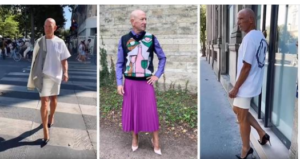
Mark Bryan is a robotics engineer who has been married for 11 years and has a daughter. He identifies as straight and chooses to dress unconventionally. Bryan is an American living in Germany, and he doesn’t believe that fashion has to be gendered. You can find Bryan wearing a skirt and heels to work or out anywhere else he goes on any given day.
Bryan said he doesn’t like how limited men’s choices are in the fashion department, especially when it comes to office attire. Men’s pants only come in a few colors, mostly black, gray, dark blue and the occasional pinstripe, and cuts.
The stylish dresser believes that if women are allowed to wear pants, men should be able to wear skirts and dresses as well. Bryan likes how skirts come in many styles and patterns – and many more colors – unlike men’s clothing.
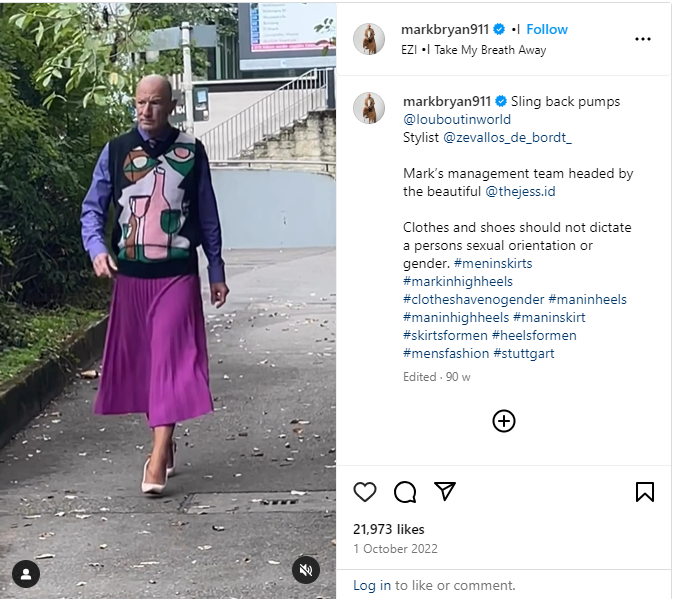
Bryan prefers to mix traditional gender looks by wearing masculine attire on his top half, like a blazer and tie, and traditionally feminine attire on the bottom half. He will typically wear a pencil skirt and four-inch heels on the bottom.
Wearing high heels is no problem for Bryan. He first learned how to do it when his college girlfriend asked him to wear high heels while dancing with her so that they were on the same level. They continued this for over a year.
Bryan doesn’t let stereotypes or assumptions stop him from dressing in a way that brings him joy. He challenges expectations and does so unapologetically. Keep reading to hear what Bryan has to say about his fashion choices.
Bryan has a very clear idea about how he likes to dress. He told Bored Panda: “To me, clothes have no gender. I prefer skirts to dresses. Dresses don’t allow me to mix the genders. I prefer a ‘masculine’ look above the waist and a non-gendered look below the waist. It’s all about clothes having no gender.”
He continued: “I am old enough to remember that in school, the girls could not wear pants. Pants have now become a non-gendered article of clothing. So why can’t skirts and heels be non-gendered? Besides, men wore heels before women did. Maybe not today’s stiletto-style heels, but men did wear heels before women.”
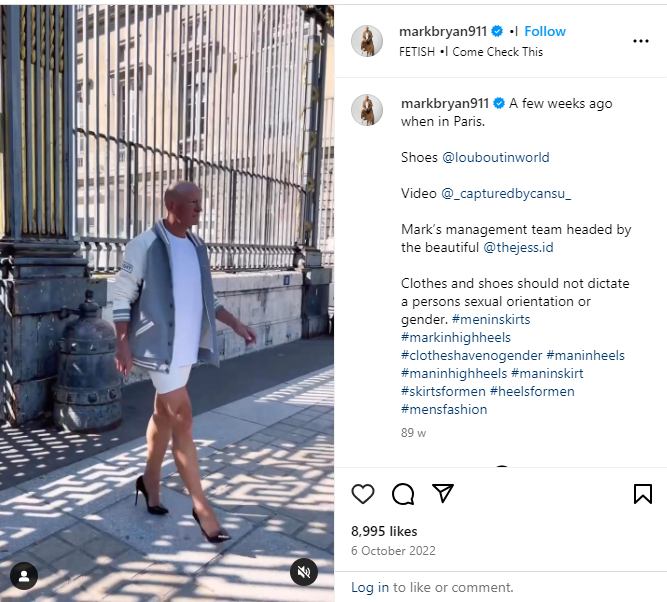
Bryan is correct about that. High heels can look back on a long history. Although historians and archaeologists cannot date their invention clearly, they have been around at least since the 10th century. And they were not a fashion statement at first. No, the first recorded use of high heels was eminently practical: the Persian cavalry wore boots with heels, called a kalash or galesh, that made it easier for them to keep their feet inside their stirrups. This is, by the way, the same reason why cowboy boots have a small heel as well!
Since owning a horse was a sign of wealth, only well-off men could afford to wear these high-heeled boots. The use of them slowly spread across Europe, and high heels heels became one of the fashion signs of rich noblemen or traders. In fact, following the Great Schism of the Christian Church in the 11th century, even the pope wore high heels.
It wasn’t until several hundred years later that fashion slowly changed. During the 18th century, cultural concerns in Europe came up about the distinction between males and females and talk about what men and women should wear arose. This is the point in time where the belief that fashion is something effeminate and frivolous that “real men” shouldn’t care about hails from. Due to these changing beliefs, men largely abandoned high heels heels, as they were seen as impractical and mere accessories.
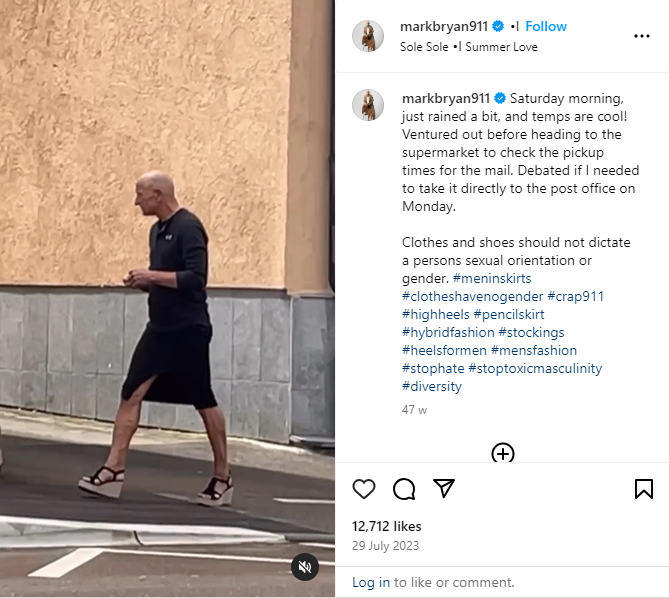
Bryan is one of the examples of how high-heels are slowly coming back as an accepted form of footwear for men. Although the engineer champions the option of wearing high-heeled shoes for men, he understands many people will look twice when they see him. He compares his style choices to someone who chooses to dye their hair bright colors. He explained:
“Take a person with bright green hair. Green hair is not normal. You look up and see this person, your mind tells you it’s a person with green hair, you think to yourself, that’s odd or interesting, then you go back to do what you were doing and don’t give it another thought. I believe this is the same when people see me in a skirt and heels.”
Bryan doesn’t have to struggle to find skirts and heels that fit him either. He wears a size 8 in skirts, and with smaller feet for a man, his shoe size in heels is 8.5. If you know a man who is considering trying out wearing heels and skirts too, Bryan suggests starting with a lower heel until you feel more comfortable walking in high heels.
What do you think of Mark Bryan’s style choices? Do you know any men who would try walking in high heels? Let us know, and be sure to send this along to your friends and family.
When I Got Home Early from Work, My Husband Offered to Give Me a Foot Massage – It Felt Suspicious, and I Was Right

I got home early, and Greg greeted me with an unusual smile and an offer to massage my feet—something he’d never done before. I wanted to believe it was kindness, but a faint click from the bathroom told me the truth: my husband was hiding a devastating secret.
It all started six years ago. I was 29, fresh out of a long-term relationship, and feeling like I’d never find someone again.

A sad young woman deep in thought | Source: Pexels
Then, one evening, Greg walked into my life. I was sitting at a bar, nursing a glass of wine after work, when he strolled over with that confident, easy smile of his.
“Mind if I sit here?” he asked, gesturing to the stool beside me.
He was tall, handsome, and had a twinkle in his eye. He was the kind of guy who seemed like he had the whole world figured out. I smiled shyly and nodded.

A man in a bar | Source: Pexels
He sat down and immediately started talking. “You look like you’ve had a long day. Let me guess—accountant?”
I laughed. “Close. Marketing.”
“Ah, I knew it. You’ve got that creative, problem-solving vibe,” he said, grinning.
From that moment, I was hooked. Greg had a way of making me feel seen, like I was the most interesting person in the room. We started dating, and within a year, we were married.

A woman leaning against a man who’s smiling while working on his laptop | Source: Pexels
At first, it was perfect. He was funny, charming, and affectionate. He made me feel like I could do anything. I thought he brought out the best in me.
But as time went on, little things started to bother me. Greg didn’t want kids. He said it wasn’t the right time, but I knew deep down he’d never change his mind. It broke my heart because I had always dreamed of a big family.

A sad woman with her back turned to a distraught man | Source: Pexels
And then there was his tendency to prioritize everyone else over me. His brother needed help moving? Greg was there. His friends wanted to hang out? He’d cancel our plans without a second thought. I told myself it was just who he was, but it hurt.
Over the years, our marriage settled into something… quiet. Too quiet. The spark that had once been there was gone. We were more like roommates than a couple.

A woman talking to her husband in the corridor | Source: Pexels
That evening, I got home early from work for the first time in weeks. I was exhausted after back-to-back meetings and just wanted to kick off my heels and relax.
When I walked in, Greg was waiting for me by the door. He had this huge grin on his face, the kind that made his dimples show.
“Long day?” he asked, leaning in to kiss my cheek.
“Yeah,” I said, dropping my bag on the console table. “Exhausting.”

A tired woman | Source: Pexels
“Perfect,” he said, clapping his hands together. “Why don’t you sit down? I’ll give you a foot massage.”
I blinked. Greg? Offering a foot massage? He usually groaned when I asked him to hand me the remote.
“Are you serious?” I asked, raising an eyebrow.
“Of course,” he said, guiding me to the couch. “You deserve to be pampered.”

A couple kissing at home | Source: Pexels
Too tired to argue, I let him slip off my shoes. His hands were surprisingly gentle as they worked on my aching feet.
“This is… nice,” I said hesitantly.
He laughed, a little too loudly. “Can’t a guy spoil his wife without it being suspicious?”
I forced a smile but couldn’t shake the feeling that something was off. This wasn’t Greg. At least, not the Greg I’d been living with for the past few years.

A serious woman sitting in her living room | Source: Midjourney
Then, I heard a faint click coming from down the hall.
I sat up straight. “Did you hear that? Like the bathroom door…”
Greg laughed nervously. “Must be the pipes. You know how this old house is.”
My stomach tightened. “Greg, what’s going on?”
“Nothing!” he said, his voice pitching higher than usual. “You’re just tired. Sit down, relax…”

A nervous man in his living room | Source: Midjourney
Ignoring him, I got up and walked toward the bathroom.
“Wait!” he called after me, panic creeping into his voice. “Where are you going?”
The hallway felt longer than usual as I made my way toward the bathroom. My pulse pounded in my ears, each step making my unease grow.

A woman walking along a corridor | Source: Midjourney
When I flung the bathroom door open, the air hit me first. It was warm and humid, like someone had just stepped out of the shower. The mirror was slightly fogged.
My heart pounded as I scanned the room. That’s when I saw it: a tube of crimson lipstick lying on the counter.
I picked it up, holding it in front of him as he approached hesitantly. “Whose is this?”
Greg’s face turned pale. “Uh… it’s yours?”

An angry woman holding her lipstick | Source: Midjourney
“Don’t insult me,” I snapped. “You know I don’t wear this color.”
Before he could respond, a muffled sneeze came from the bedroom.
My breath caught. I looked at Greg, who was visibly sweating now.
“Care to explain that?” I asked, my voice icy.

A couple arguing in their home | Source: Pexels
He stammered, “It’s nothing. Really. I swear…”
I didn’t wait to hear the rest. With my heart racing, I headed for the bedroom.
Greg scrambled behind me, his voice rang out, desperate. “Wait, don’t!”
Ignoring him, I flung the closet door open.

An angry woman opening her closet | Source: Midjourney
A woman crouched there, clutching a pair of high heels to her chest. She looked startled, like a deer caught in headlights. Her hair was mussed, and she was wearing a silk robe that I instantly recognized as mine.
I stared at her, my mind reeling. “Who are you?” I demanded, my voice sharper than I’d ever heard it.

An angry woman shouting at her husband’s mistress | Source: Midjourney
She stood up slowly, her face flushing red. “This isn’t what it looks like,” she said, brushing at the robe like that would somehow make everything better.
Greg stepped into the room, his hands raised like he was trying to calm a wild animal. “Honey, please, let me explain.”
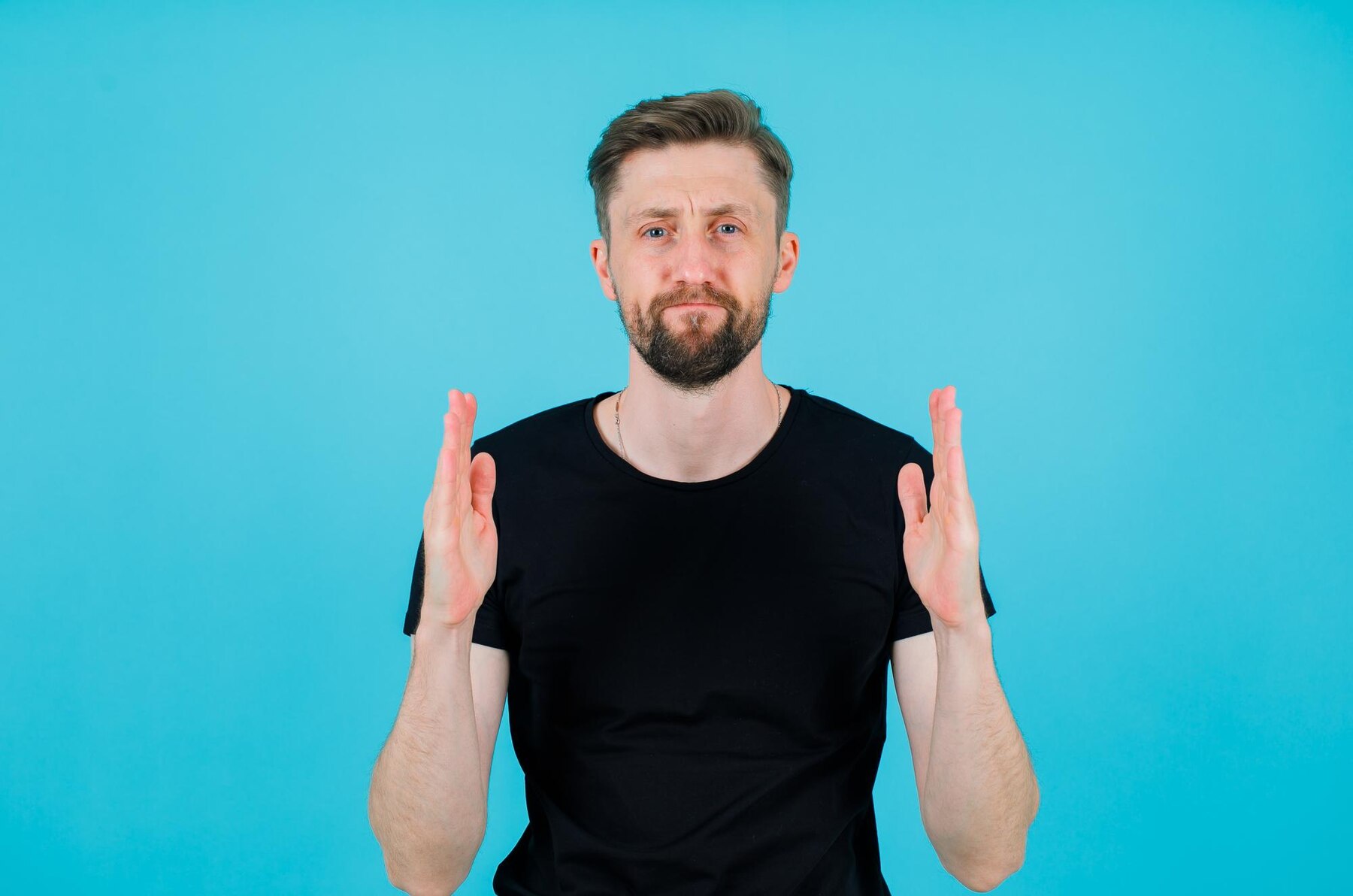
An apologetic man holding his hands up | Source: Freepik
I turned on him, the fury rising in my chest. “Explain? Explain what, Greg? That there’s a strange woman hiding in our bedroom? Wearing my robe?” I gestured to the woman, who was now fidgeting awkwardly.
“Listen, I didn’t mean for you to find out like this,” the woman said weakly.

A shocked woman sitting in bed | Source: Midjourney
“Find out what?” I snapped, my voice shaking. “That my husband is a lying cheat? That he brings his little girlfriend here when I’m at work? Don’t try to defend him!”
“Babe, please, don’t do this,” Greg begged, stepping closer to me.
“Don’t you dare call me ‘babe,'” I hissed, stepping back. “You think you can sweet-talk your way out of this? Pack your things and go. Now. Both of you.”

An angry woman in her bedroom | Source: Midjourney
The woman looked at Greg, wide-eyed. “I thought you said she wouldn’t be home.”
My stomach churned at her words, but I refused to let the tears fall. I turned back to Greg. “Get her out of my house. And don’t bother coming back.”
Greg held his hands up in surrender. “Just give me a chance to explain—”
“Leave!” I shouted, my voice echoing off the walls.

A woman shouting in her bedroom | Source: Midjourney
The woman grabbed her shoes and scurried out of the room. Greg hesitated for a moment, his mouth opening as if to argue. But when he saw the look on my face, he seemed to think better of it.
He left without another word, following her out the front door.
I stood in the middle of the bedroom, the weight of what had just happened pressing down on me. For a moment, I felt numb. But then something shifted.

A sad woman in the middle of her living room | Source: Midjourney
This was my house. My life. And I wasn’t going to let Greg taint it any longer.
I grabbed a box from the garage and started packing his things. His clothes, his toiletries, even the stupid coffee mug he loved went into the box. I worked quickly, methodically, not letting myself dwell on the memories tied to each item.
As I was finishing up, I called my brother. “Can you come over?” I asked, my voice steady but tired.

A tired woman looking at her phone | Source: Pexels
“Of course,” he said without hesitation. “What’s going on?”
“Greg’s gone,” I said simply.
My brother arrived half an hour later, his presence a welcome relief. He didn’t ask many questions, just hugged me and helped me carry Greg’s belongings to the front door.
By the time Greg returned the next night, I was ready.

A nervous man standing on a porch | Source: Midjourney
He walked in, looking sheepish and hopeful. “Can we talk?” he asked softly.
I pointed to the pile of his belongings by the door. “No, Greg. We’re done.”
“Please, just hear me out—”
“I don’t want to hear it,” I said firmly. “Take your things and go.”

An angry woman standing in her doorway | Source: Midjourney
He stood there for a moment, as if he thought I might change my mind. When I didn’t, he sighed, grabbed his things, and walked out the door for the last time.
The next day, I filed for divorce. It felt strange, almost surreal, but also like a weight had been lifted off my shoulders.

Divorce papers on the table | Source: Pexels
Over the next few months, I started to reclaim my life. I redecorated the house, filling it with things that made me happy. I spent time with friends and family, people who reminded me of who I was before Greg came along.
It wasn’t easy. There were moments when I felt angry, hurt, and lonely. But each day, I felt a little lighter. A little freer.

A woman looking out of her window | Source: Pexels
One evening, as I sat in my newly redecorated living room, I looked around and realized something: I was happy. Truly happy.
Greg’s betrayal had been painful, but it had also been a wake-up call. I had spent so much time trying to make our marriage work that I’d forgotten my own worth. Now, I was finally putting myself first.

A tired woman in her office | Source: Pexels
As I closed the chapter on my marriage, I felt hopeful for the future. Whatever came next, I knew I was strong enough to face it.
Liked this story? Consider checking out this one: When a charming stranger knocked on my door, mistaking me for the cleaning lady, I decided to play along. But what began as an amusing misunderstanding quickly unraveled into a shocking revelation.
This work is inspired by real events and people, but it has been fictionalized for creative purposes. Names, characters, and details have been changed to protect privacy and enhance the narrative. Any resemblance to actual persons, living or dead, or actual events is purely coincidental and not intended by the author.
The author and publisher make no claims to the accuracy of events or the portrayal of characters and are not liable for any misinterpretation. This story is provided “as is,” and any opinions expressed are those of the characters and do not reflect the views of the author or publisher.



Leave a Reply